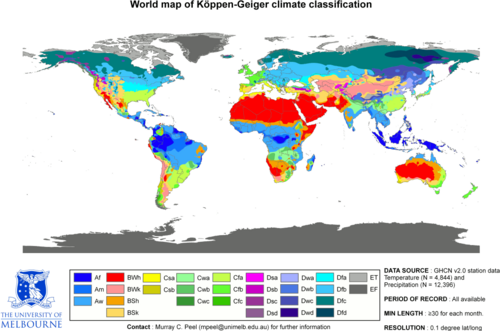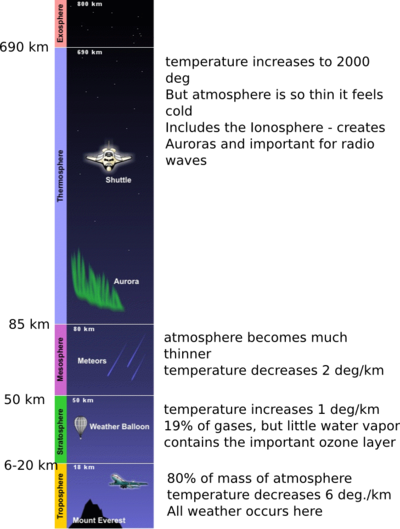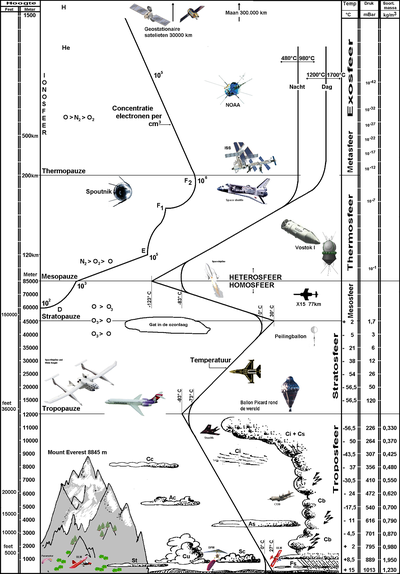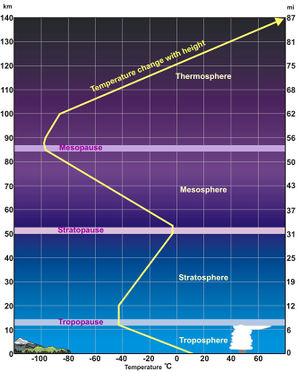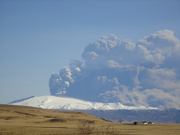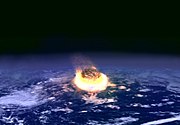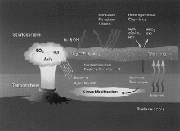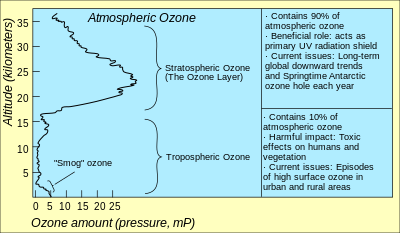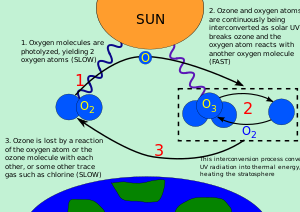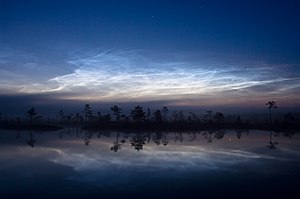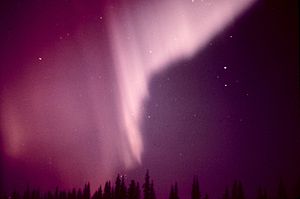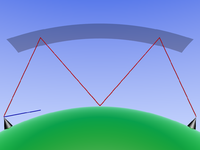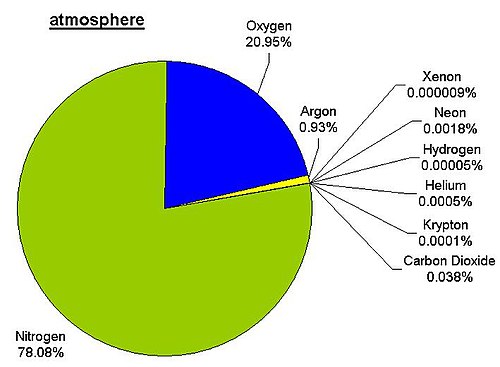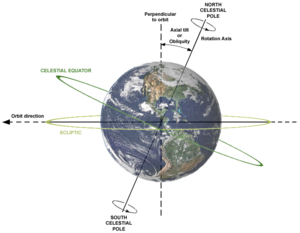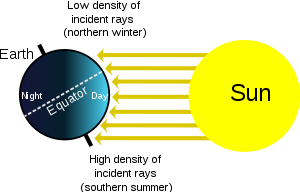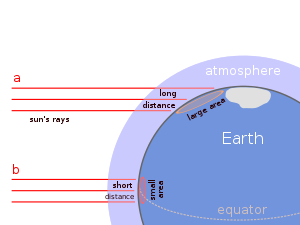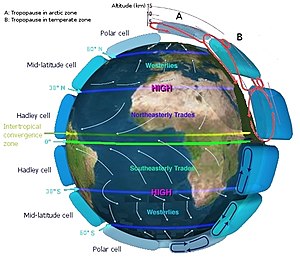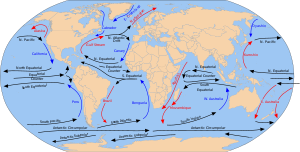Atmosphere and Climate
| Environmental Science | |
|---|---|
| Topics | What is the Environment | Planetary Boundaries | Ecological Footprint and Sustainable Development | Food and Agriculture | Population | Ecology - Definitions and Outline | Energy Flow in Ecosystems | Population and Community Ecology | Material Cycles | Biodiversity | Energy | Atmosphere and Climate | Global Warming | Air Quality | Water Quantity | Water Quality | Solid Waste |
Contents
Atmospheric layers
The atmosphere is composed of layers as shown in the diagrams below:
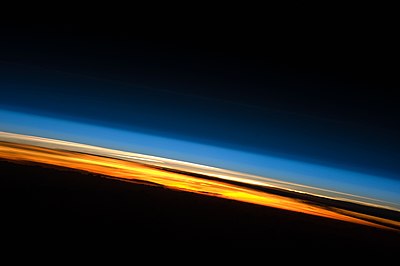
Troposphere
The troposphere is the layer closest to the Earth's surface and contains 80% of the atmosphere's mass. Importantly, all of the weather occurs in the troposphere.
The temperature in the troposphere decreases by 6 degrees for every km above the surface:
We will look at the structure of the troposphere in the section on climate below.
Stratosphere
The stratosphere is the layer above the troposphere. Here the temperature increases slightly versus height.
It contains about 19% of the mass of the atmosphere. The lower density of the stratosphere (compared to the troposphere) is important. For example, intercontinental airplanes fly here due to less resistance and therefore lower fuel usage.
Even though the weather is in the troposphere; the stratosphere does have an influence on the weather. Phenomena such as the changes in the polar vortex affects the weather (for example, see this article).
Stratospheric Aerosols
Aerosols, mainly ash from volcanoes, can be thrown into the stratosphere. Once in the stratosphere, it can remain for a long time and move a long distance, sometimes even circling the Earth many times. The main effect of these aerosols is to reflect sunlight and cause cooling.
The most famous example of the effect of aerosols is on the dinosaurs. The extinction of dinosaurs (and many other organisms such as marine reptiles and pterosaurs) is now believed to be related to the impact of the Earth by an asteroid. The impact forced a huge amount of aerosols into the stratosphere, causing a major shift in the Earth's climate. This in turn caused the mass extinction.
Ozone Layer
Contained in the lower part of the stratosphere is the ozone layer.
Formation of ozone:
- O2 + hν → O + O
- O + O2 → O3 (ozone)
This ozone then absorbs ultraviolet (UV) radiation:
- O3 + hν(UV) → O2 + O
- O + O2 → O3
Thus the ozone protects the Earth from dangerous ultraviolet radiation. If it wasn't for this layer life could not exist -- too much radiation would reach the surface.
This absorption of radiation is what causes the increase in temperature in the stratosphere.
Mesosphere
The mesosphere is defined as where the temperature starts to decrease again with height.
The mesosphere is where most meteors burn up in the atmosphere.
The mesosphere is poorly understood (since it is too high for balloons and too low for satellites).
One interesting phenomena that occurs in the mesosphere are noctilucent clouds. They are clouds of ice crystals about 80 km above the Earth's surface. It is believed caused by ice condensing on meteoric dust.
Other interesting phenomena include blue jets and sprites.
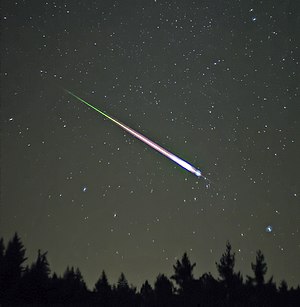
Thermosphere
In the thermosphere, the temperature starts to increase again due to solar radiation. It is the biggest layer (extending up to 700 km) and is where the International Space Station is located.
Ionosphere
An important part of the thermosphere is the ionosphere, a region where the solar radiation is strong enough to split electrons off atoms to form ions.
A spectacular aspect of the ionosphere are the auroras. Auroras are light emitted when particles from the sun (known as solar storms) hit the Earth's magnetic field, causing light to be emitted. Auroras can only be found near the poles.
Another important aspect of the ionosphere is that it allows radio waves to travel long distances. The waves refract off the ionosphere directing them back to Earth.
Exosphere
The Exosphere is the layer where particles are still bound by Earth's gravity, but too far apart to interact. Beyond the exosphere is outer space. It does not play a major role in the environment.
Atmospheric composition (troposphere)
The numbers in the diagram consider a dry atmosphere. Water vapor accounts for 0-4%.
Climate (in the troposphere)
The Earth's weather and climate are determined by three main factors.
- The tilt of the Earth's axis
- The rotation of the Earth (known as the Coriolis effect)
- The ocean currents
The fact is that axis the Earth rotates on is not perpendicular to the orbit of the sun (the ecliptic), but is tilted at about 23 degrees. The effect of this axial tilt can be seen on the seasons. The following figures shows the axial tilt and this effect.
Also the sun takes longer to reach the poles than the equator, therefore the light is spread out over a wider area and is less intense.
This effect and the rotation of the Earth causes major cells in the atmospheric circulation to occur.
Here the sun heats the air at the equator, this air rises and as it rises it cools down. Cold air can hold less moisture, so it rains. This air masses then moves away from the equator due to the Earth's rotation. This further cools it until it gets too heavy and moves back to the surface. When it falls it now warms up absorbing moisture and causes arid conditions (most deserts are around 30 degrees North and South). This then repeats.
Also important are the ocean currents:
Warm currents (red) can create warmer than normal climates to an area (for example, British Isles and Japan). Likewise cold currents (blue) can affect climates (for example, penguins near the Equator off South America).
Putting the above together gives us climates zones. There are a number of different classification schemes, but the most commonly used is the Köppen-Geiger system.
